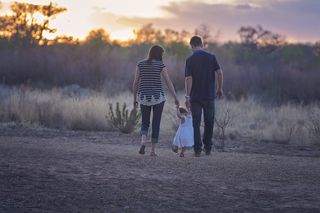Environment
On a Baby's First Steps
How the act of moving opens up a brave new world for babies (and parents)
Posted June 3, 2019 Reviewed by Lybi Ma
Last month, my 14-month-old son Charlie did what a lot of babies his age typically do—he started walking. For most new parents, watching babies take their very first steps is an exciting new milestone. Indeed, independent locomotion is an important achievement, as it allows babies to move away from the confines of their parents’ arms and explore new places, find new things, and engage with new people, thereby opening up brand new possibilities for learning. But, while motor milestones bring new possibilities for babies, they can also come with some growing pains for parents. And those growing pains may start well before babies take their first steps.
Babies are developing different kinds of amazing new abilities long before they start walking. One of the very first motor milestones babies achieve is the act of reaching, which begins around 3 months of age. The ability to reach for objects might seem simple and relatively insignificant to you. But reaching is the first time babies can willfully direct their bodies toward specific objects. Before they could reach, getting their hands into their mouths was about the most exciting thing they could do. With the onset of reaching, they can manipulate objects for the very first time, perhaps even throw them on the floor, learning that they can have an effect on the outside world. After babies start reaching, you’ll notice that the toys they had no interest in before are suddenly new and exciting. They will start shaking, hitting, and possibly mouthing everything they can get their hands on, as a way of exerting control over their environments.

A few months after reaching comes independent sitting, which develops typically between 4 and 8 months of age. Once infants can sit up on their own, they can manipulate objects much more easily. Although babies can reach for and hold objects before they sit independently, they have trouble doing so if they are lying on their backs or on their bellies. When holding a toy while laying on their backs, babies run into the problem of having to fight gravity, which leads to the inevitable self-face punch from time to time. When babies can sit up by themselves, holding and looking at objects is easier—they can turn objects around, move them from one hand to the other, and even play with two different things at the same time. In fact, there is evidence that independent sitting teaches babies a lot about objects. For example, research suggests that babies between the ages of 4 and 6 months are only first learning that objects have three dimensions, and when you show them a partial view of a 3-D object, they only slowly begin to realize that the same object looks different from different angles (Soska & Johnson, 2008). A follow-up study showed that independent sitting is what gives rise to this ability, and it is predicted by the onset of sitting and how much sitting infants manipulate different objects (Soska, Adolph, & Johnson, 2010). In other words, experience sitting upright, and in turn, playing with objects, helps teach babies about their 3D properties.
After sitting comes crawling, which develops between 6 and 10 months of age, and marks the very first time babies can move from one place to another by themselves. Moving around independently teaches babies important information about their environments, and helps them begin to understand how to use depth as a cue for how to navigate the world safely (Campos, Bertenthal, & Kermoian, 1992). It also creates new opportunities for social interactions, as babies can now carry objects for the first time and bring them to caregivers for play (Karasik, Tamis-LeMonda, and Adolph, 2011). Despite their newfound freedom, because of the mechanics of hands-and-knees crawling, crawlers spend most of their time looking at the floor and have to stop and sit mid-crawl if they want to get a full view of the scene ahead (Kretch, Franchak, & Adolph, 2014). And although they can carry objects while crawling, it’s difficult, since they have to keep the object in their hand while simultaneously using that hand to move (Karasik, Zuckerman, & Adolph, 2012). When they finally start walking—around 13 to 15 months—they can now navigate the environment with a full view of the scene ahead, making it easier to carry toys, and importantly, engage their caregivers in play.
It is clear from this research that movement, and independent mobility in particular, changes a baby’s world in many ways. But importantly, it also changes both the physical and social world for parents as well. When a baby begins to reach and manipulate objects, it means they can (and will) throw them on the floor, sometimes over and over and over again. They can reach for objects that you don’t want them to have, often putting those objects into their mouths. This gets easier for them as they begin to sit independently, and especially when they start crawling and walking: Now the problem of obtaining forbidden objects grows exponentially, and all of a sudden any object that is within their height is suddenly also within their tiny grasp. Babies can now gain access to things like household plants, electrical sockets, and (in our house) dog food.
Besides the potential risks of what they can touch, there is also the risk of falling from a bed or couch, or worse—a flight of stairs. Heights don’t mean much to babies who are first learning to crawl and walk—they aren’t afraid of them, which makes the early days of locomotion all the more tense. Although independent locomotion does teach infants to use depth to navigate the world safely, it takes months of experience for this ability to develop (Adolph, 2000). And, during these months infants are moving around a lot. In fact, between the ages of 12 and 19 months, infants take on average over 2,000 steps in an hour and fall about 17 times (Adolph et al., 2012). Luckily, most of those falls aren’t from high ground, and babies barely notice them.
Altogether, these changes in babies’ ability to navigate their environments means that parents have to deal with the constant game of objects (and food) being thrown on the floor or across the room, they need to baby-proof their homes, say “no” for the first time, and perhaps even start to make rules. And since rules can easily be broken, parents might even find themselves getting angry at their little “angels” for the very first time (Campos, Anderson, Barbu-Roth, Hubbard, Hertenstein, & Witherington, 2000).
So babies’ first steps change more than just their repertoire of behavior—they also change the social environment, in many, mostly wonderful, but in some difficult ways. So why are we in such a rush for our babies to walk? Besides the excitement and joy of seeing those very first steps, the word “milestone” can make a lot of parents nervous. It implies that babies need to reach each one and that any delay could be a sign of something wrong. But, it’s important to note that not all motor milestones are required—many babies, for example, skip crawling altogether—and different kinds of environments can shift the timing of motor milestones significantly. For example, certain types of exercise, like tummy time, can speed up motor milestones (Hopkins and Westra, 1988; Zelazo, Zelazo, & Kolb, 1972), while restrictions in movement, via swaddling or frequent carrying, can slow them down (e.g., Karasik, Ossmy, Tamis-LeMonda, & Adolph, 2018). There are also a wide variety of cultural variations in when babies sit, crawl, and walk that are related to common handling practices (Karasik, Tamis-LeMonda, Adolph, & Bornstein, 2015). Major motor delays—for example, if your baby shows no signs of reaching for objects by 6 months or no signs of walking by 18 to 24 months—may warrant seeing a specialist, but it’s important to remember that all typically developing infants will eventually learn to walk. And when they do, it opens up an exciting new world of learning possibilities, for the baby and for the parent.
References
Adolph, K. E. (2000). Specificity of learning: Why infants fall over a veritable cliff. Psychological Science, 11, 290-295.
Adolph, K. E., Cole, W. G., Komati, M., Garciaguirre, J. S., Badaly, D., Lingeman, J. M., ... & Sotsky, R. B. (2012). How do you learn to walk? Thousands of steps and dozens of falls per day. Psychological Science, 23, 1387-1394.
Campos, J. J., Anderson, D. I., Barbu-Roth, M. A., Hubbard, E. M., Hertenstein, M. J., & Witherington, D. (2000). Travel broadens the mind. Infancy, 1, 149-219.
Campos, J. J., Bertenthal, B. I., & Kermoian, R. (1992). Early experience and emotional development: The emergence of wariness of heights. Psychological Science, 3, 61-64.
Hopkins, B., & Westra, T. (1988). Maternal handling and motor development: An intracultural study. Genetic, social, and general psychology monographs, 114, 377-408.
Karasik, L. B., Adolph, K. E., Tamis-LeMonda, C. S., & Zuckerman, A. L. (2012). Carry on: Spontaneous object carrying in 13-month-old crawling and walking infants. Developmental psychology, 48(2), 389.
Karasik, L. B., Ossmy, O., Tamis-LeMonda, C. S., & Adolph, K. E. (2018). The ties that bind: Cradling in Tajikistan. PLoS ONE, 13, e0204428.
Karasik, L. B., Tamis‐LeMonda, C. S., & Adolph, K. E. (2011). Transition from crawling to walking and infants’ actions with objects and people. Child Development, 82, 1199-1209.
Karasik, L. B., Tamis-LeMonda, C. S., Adolph, K. E., & Bornstein, M. H. (2015). Places and Postures: A Cross-Cultural Comparison of Sitting in 5-Month-Olds. Journal of Cross-Cultural Psychology, 46, 1023-1038.
Kretch, K. S., Franchak, J. M., & Adolph, K. E. (2014). Crawling and walking infants see the world differently. Child development, 85, 1503-1518.
Soska, K. C., Adolph, K. E., & Johnson, S. P. (2010). Systems in development: motor skill acquisition facilitates three-dimensional object completion. Developmental Psychology, 46, 129-138.
Soska, K. C., Johnson, S. P. (2008). Development of three-dimensional object completion in infancy. Child Development, 79, 1230–1236.
Zelazo, P. R., Zelazo, N. A., & Kolb, S. (1972). " Walking" in the Newborn. Science, 176(4032), 314-315.


